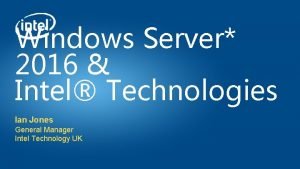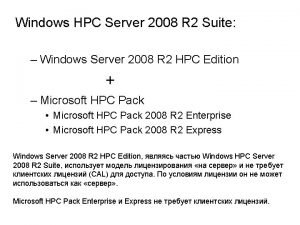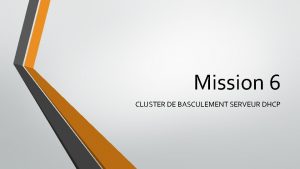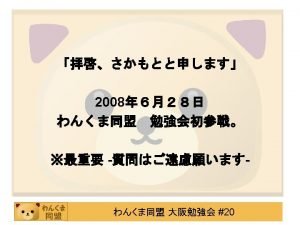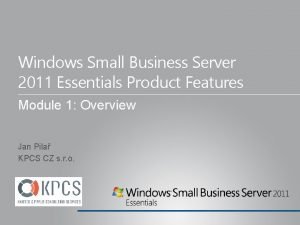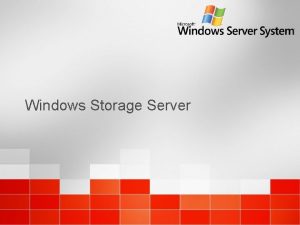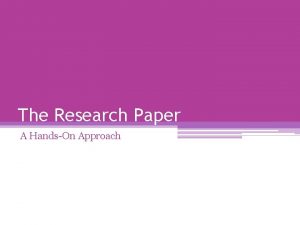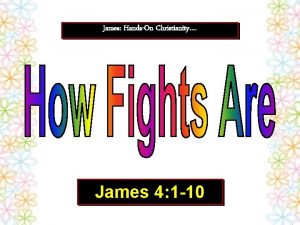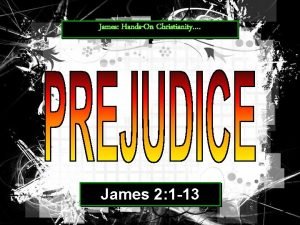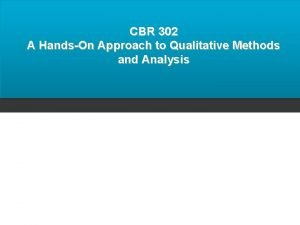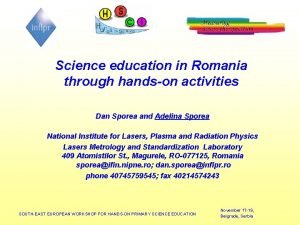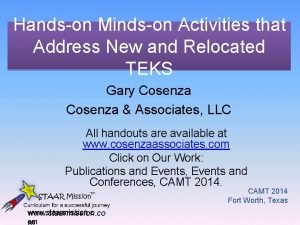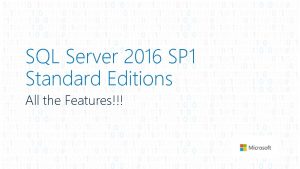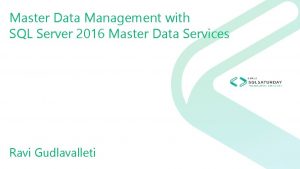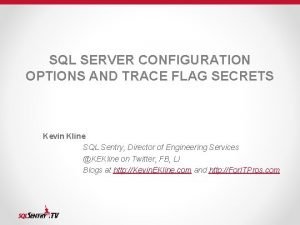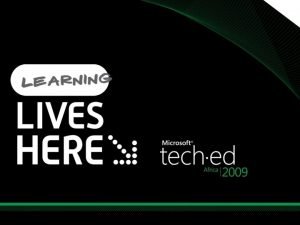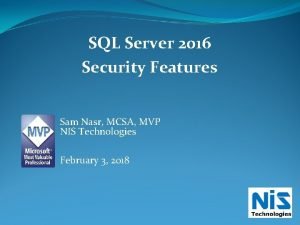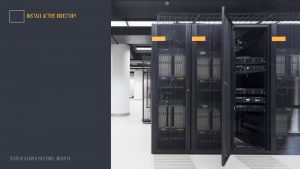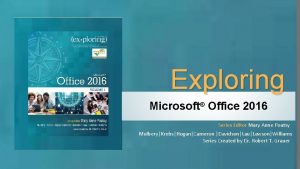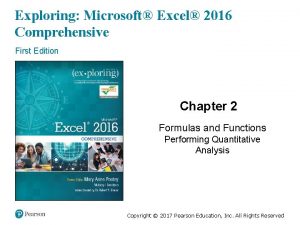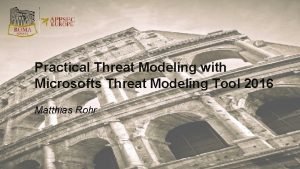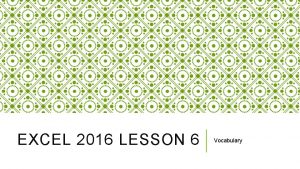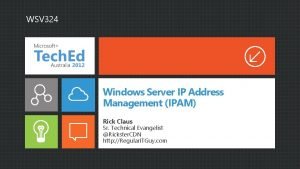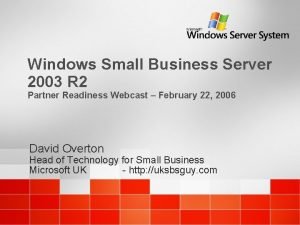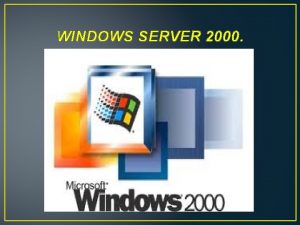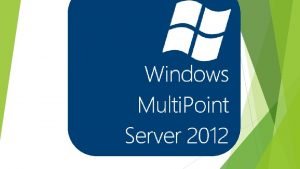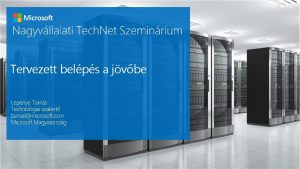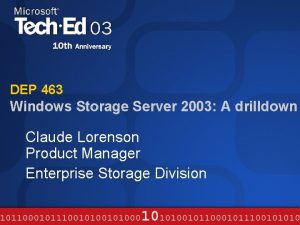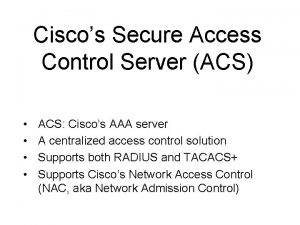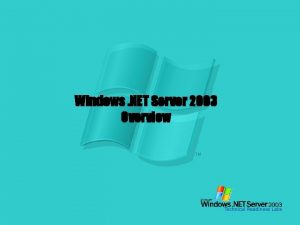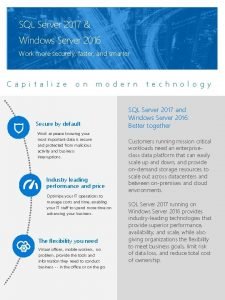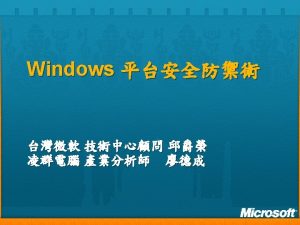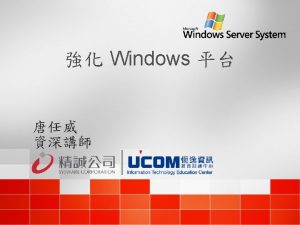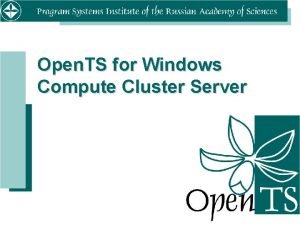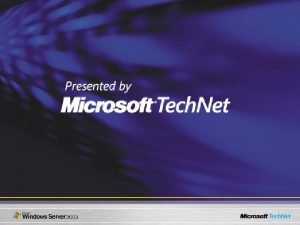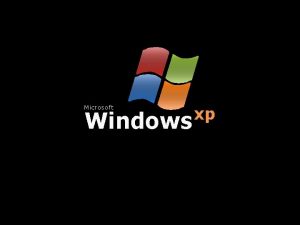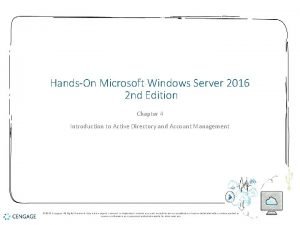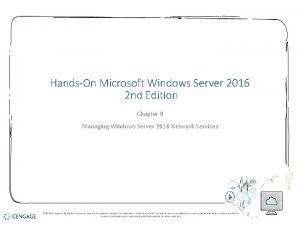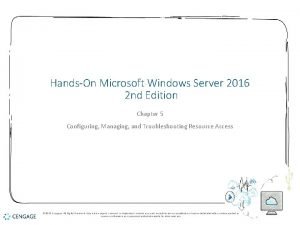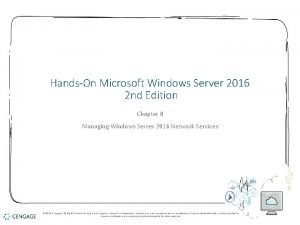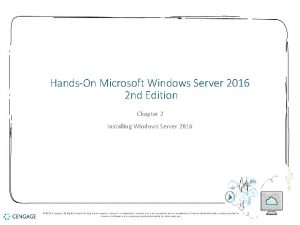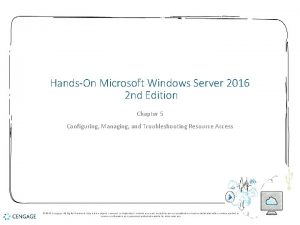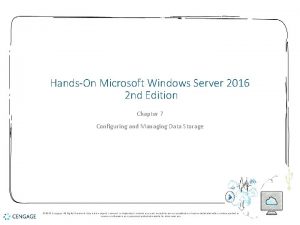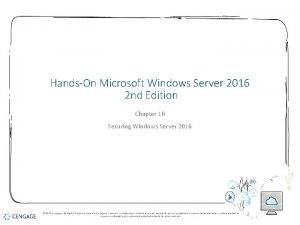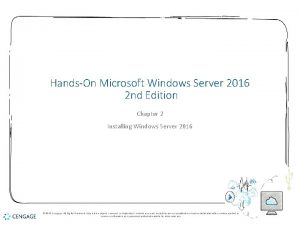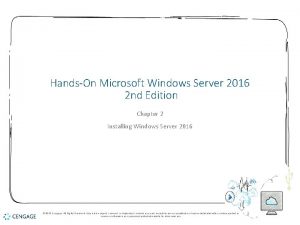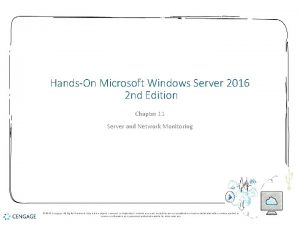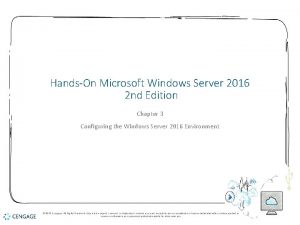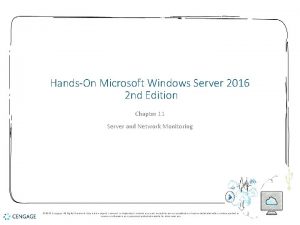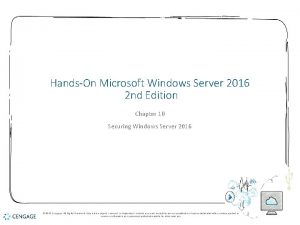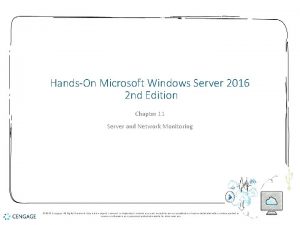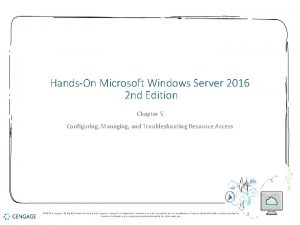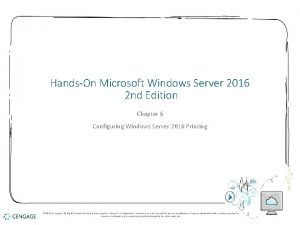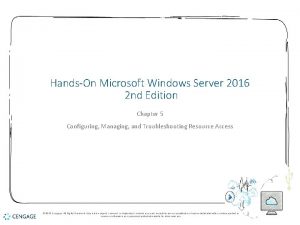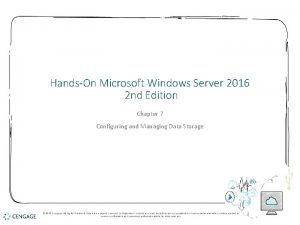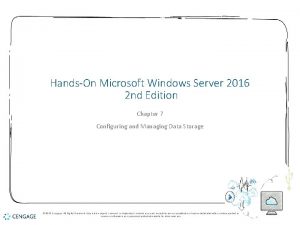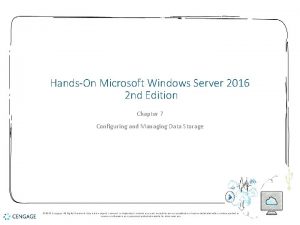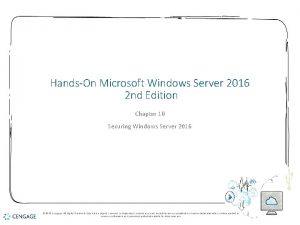HandsOn Microsoft Windows Server 2016 2 nd Edition



















































- Slides: 51

Hands-On Microsoft Windows Server 2016 2 nd Edition Chapter 4 Introduction to Active Directory and Account Management © 2018 Cengage. All Rights Reserved. May not be copied, scanned, or duplicated, in whole or in part, except for use as permitted in a license distributed with a certain product or service or otherwise on a password-protected website for classroom use.

Objectives Understand Active Directory basic concepts Install and configure Active Directory Implement Active Directory containers Understand Azure Active Directory Create and manage user accounts Configure and use security groups Understand user profiles Describe important additional features in Active Directory © 2018 Cengage. May not be copied, scanned, or duplicated, in whole or in part, except for use as permitted in a license distributed with a certain product or service or otherwise on a passwordprotected website for classroom use.

Active Directory Basics (1 of 4) • Active Directory • Directory service that houses information about all network resources such as servers, printers, user accounts, groups of user accounts, security policies, and other information • Directory service • Responsible for providing a central listing of resources and ways to quickly find access specific resources and for providing a way to manage network resources • Windows Server 2016 uses Active Directory to manage accounts, groups, and many more network management services © 2018 Cengage. All Rights Reserved. May not be copied, scanned, or duplicated, in whole or in part, except for use as permitted in a license distributed with a certain product or service or otherwise on a password-protected website for classroom use. 3

Active Directory Basics (2 of 4) • Domain controllers (DCs) • Servers that have the AD DS server role installed • Contain writable copies of information in Active Directory • Member servers • Servers on a network managed by Active Directory that do not have Active Directory installed • Domain • Container that holds information about all network resources that are grouped within it • Every resource is called an object © 2018 Cengage. All Rights Reserved. May not be copied, scanned, or duplicated, in whole or in part, except for use as permitted in a license distributed with a certain product or service or otherwise on a password-protected website for classroom use. 4

Active Directory Basics (3 of 4) • Multimaster replication • Each DC is equal to every other DC in that it contains the full range of information that composes Active Directory • If information on one DC changes it is replicated to all other DCs • Active Directory is built to make replication efficient • Active Directory in Windows Server 2016 can: • Replicate individual properties instead of entire accounts • Replicate Active Directory on the basis of the speed of the network link • Three general concepts important for understanding Active Directory: • Schema • Global catalog • Namespace © 2018 Cengage. All Rights Reserved. May not be copied, scanned, or duplicated, in whole or in part, except for use as permitted in a license distributed with a certain product or service or otherwise on a password-protected website for classroom use. 5

Active Directory Basics (4 of 4) © 2018 Cengage. All Rights Reserved. May not be copied, scanned, or duplicated, in whole or in part, except for use as permitted in a license distributed with a certain product or service or otherwise on a password-protected website for classroom use. 6

Schema (1 of 2) • Active Directory schema • Defines the objects and the information pertaining to those objects that can be stored in Active Directory • Like a small database of information associated with that object • Schema information for objects in a domain is replicated on every DC • User account • One class of object in Active Directory that is defined through schema elements unique to that class © 2018 Cengage. All Rights Reserved. May not be copied, scanned, or duplicated, in whole or in part, except for use as permitted in a license distributed with a certain product or service or otherwise on a password-protected website for classroom use. 7

Schema (2 of 2) © 2018 Cengage. All Rights Reserved. May not be copied, scanned, or duplicated, in whole or in part, except for use as permitted in a license distributed with a certain product or service or otherwise on a password-protected website for classroom use. 8

Global Catalog (1 of 2) • Global catalog • Stores information about every object within a forest • The first DC configured in a forest becomes the global catalog server • Global catalog server • Store a full replica of every object within its own domain and a partial replica of each object within every domain in the forest • The global catalog server enables forest-wide searches of data © 2018 Cengage. All Rights Reserved. May not be copied, scanned, or duplicated, in whole or in part, except for use as permitted in a license distributed with a certain product or service or otherwise on a password-protected website for classroom use. 9

Global Catalog (2 of 2) • The global catalog serves the following purposes: • Serving as the central storehouse of key object information in a forest that has multiple domains • Providing lookup and access to all resources in all domains • Providing replication of key Active Directory elements • Keeping a copy of the most used attributes for each object for quick access • By default, the first DC in the forest is automatically designated as the global catalog server • You have the option of configuring another DC to be a global catalog server as well as designating multiple DCs as global catalog servers © 2018 Cengage. All Rights Reserved. May not be copied, scanned, or duplicated, in whole or in part, except for use as permitted in a license distributed with a certain product or service or otherwise on a password-protected website for classroom use. 10

Namespace • Active Directory uses Domain Name System (DNS) • There must be a DNS server on the network that Active Directory can access • DNS • A TCP/IP-based name service that converts computer and domain host names to dotted decimal addresses and vice versa, through a process called name resolution • Namespace • A logical area on a network that contains directory services and named objects • Has the ability to perform name resolution • Active Directory employs two kinds of namespaces: • Contiguous – one in which every child object contains the name of the parent object • Disjointed – when the child name does not resemble the name of its parent object © 2018 Cengage. All Rights Reserved. May not be copied, scanned, or duplicated, in whole or in part, except for use as permitted in a license distributed with a certain product or service or otherwise on a password-protected website for classroom use. 11

Containers in Active Directory • Active Directory has a treelike structure • The hierarchical elements, or containers, of Active Directory include forests, trees, domains, organizational units (OUs), and sites © 2018 Cengage. All Rights Reserved. May not be copied, scanned, or duplicated, in whole or in part, except for use as permitted in a license distributed with a certain product or service or otherwise on a password-protected website for classroom use. 12

Forest (1 of 5) • Forest • Consists of one or more Active Directory trees that are in a common relationship • Forests have the following characteristics: The trees can use a disjointed namespace All trees use the same schema All trees use the same global catalog Domains enable administration of commonly associated objects, such as accounts and other resources, within a forest • Two-way transitive trusts are automatically configured between domains within a single forest • • © 2018 Cengage. All Rights Reserved. May not be copied, scanned, or duplicated, in whole or in part, except for use as permitted in a license distributed with a certain product or service or otherwise on a password-protected website for classroom use. 13

Forest (2 of 5) © 2018 Cengage. All Rights Reserved. May not be copied, scanned, or duplicated, in whole or in part, except for use as permitted in a license distributed with a certain product or service or otherwise on a password-protected website for classroom use. 14

Forest (3 of 5) • A forest provides a means to relate trees that use a contiguous namespace in domains within each tree • But that have disjointed namespaces in relationship to each other • The advantage of joining trees into a forest is that all domains share the same schema and global catalog • Forest functional level • Refers to the Active Directory functions supported forest-wide © 2018 Cengage. All Rights Reserved. May not be copied, scanned, or duplicated, in whole or in part, except for use as permitted in a license distributed with a certain product or service or otherwise on a password-protected website for classroom use. 15

Forest (4 of 5) • Windows Server 2016 Active Directory recognizes several types of forest functional levels: • • Windows 2000 Native Forest Functional Level Windows Server 2003 Forest Functional Level Windows Server 2008 R 2 Forest Functional Level Windows Server 2012 Forest Functional Level Windows Server R 2 Forest Functional Level Windows Server 2016 Forest Functional Level • When servers are upgraded, it might make sense to raise the forest functional level to match the server OSs in use © 2018 Cengage. All Rights Reserved. May not be copied, scanned, or duplicated, in whole or in part, except for use as permitted in a license distributed with a certain product or service or otherwise on a password-protected website for classroom use. 16

Forest (5 of 5) © 2018 Cengage. All Rights Reserved. May not be copied, scanned, or duplicated, in whole or in part, except for use as permitted in a license distributed with a certain product or service or otherwise on a password-protected website for classroom use. 17

Tree (1 of 2) • Tree • Contains one or more domains that are in a common relationship • Tree has the following characteristics: • • Domains are represented in a contiguous namespace and can be in a hierarchy Two-way trust relationships exist between parent domains and child domains All domains in a single tree use the same schema for all types of common objects All domains use the same global catalog © 2018 Cengage. All Rights Reserved. May not be copied, scanned, or duplicated, in whole or in part, except for use as permitted in a license distributed with a certain product or service or otherwise on a password-protected website for classroom use. 18

Tree (2 of 2) • The domains in a tree typically have a hierarchical structure • Such as a root domain at the top and other domains under the root • The domains within a tree are in what is called a Kerberos transitive trust relationship • Which consists of two-way trusts between parent domains and child domains • Because of the trust relationship between parent and child domains, any one domain can have access to the resources of all others © 2018 Cengage. All Rights Reserved. May not be copied, scanned, or duplicated, in whole or in part, except for use as permitted in a license distributed with a certain product or service or otherwise on a password-protected website for classroom use. 19

Domain (1 of 3) • Microsoft views a domain as a logical partition within an Active Directory forest • A domain is a grouping of objects that typically exists as a primary container within Active Directory • The basic functions of a domain are as follows: • To provide an Active Directory ‘‘partition’’ in which to house objects that have a common relationship, particularly in terms of management and security • To establish a set of information to be replicated from one DC to another • To expedite management of a set of objects © 2018 Cengage. All Rights Reserved. May not be copied, scanned, or duplicated, in whole or in part, except for use as permitted in a license distributed with a certain product or service or otherwise on a password-protected website for classroom use. 20

Domain (2 of 3) © 2018 Cengage. All Rights Reserved. May not be copied, scanned, or duplicated, in whole or in part, except for use as permitted in a license distributed with a certain product or service or otherwise on a password-protected website for classroom use. 21

Domain (3 of 3) • Domain functional levels • Refers to the Windows Server operating systems on domain controllers and the domain-specific functions they support • The domain functional levels are as follows: • • Windows 2000 Domain Functional Level Windows Server 2003 Domain Functional Level Windows Server 2008 R 2 Domain Functional Level Windows Server 2012 R 2 Domain Functional Level Windows Server 2016 Domain Functional Level © 2018 Cengage. All Rights Reserved. May not be copied, scanned, or duplicated, in whole or in part, except for use as permitted in a license distributed with a certain product or service or otherwise on a password-protected website for classroom use. 22

Organizational Unit (1 of 2) • Organizational unit (OU) • Offers a way to achieve more flexibility in managing the resources associated with a business unit, department, or division - Than is possible through domain administration alone • An OU is a grouping of related objects within a domain • OUs allow the grouping of objects so that they can be administered using the same group policies • OUs can be nested within OUs © 2018 Cengage. All Rights Reserved. May not be copied, scanned, or duplicated, in whole or in part, except for use as permitted in a license distributed with a certain product or service or otherwise on a password-protected website for classroom use. 23

Organizational Unit (2 of 2) • When you plan to create OUs, keep three concerns in mind: • Microsoft recommends that you limit OUs to 10 levels or fewer • Active Directory works more efficiently when OUs are set up horizontally instead of vertically • The creation of OUs involves more processing resources because each request through an OU requires CPU time © 2018 Cengage. All Rights Reserved. May not be copied, scanned, or duplicated, in whole or in part, except for use as permitted in a license distributed with a certain product or service or otherwise on a password-protected website for classroom use. 24

Site (1 of 3) • Site • A TCP/IP-based concept (container) within Active Directory that is linked to IP subnets • A site has the following functions: • • • Reflects one or more interconnected subnets Reflects the physical aspect of the network Is used for DC replication Is used to enable a client to access the DC that is physically closest Is composed of only two types of objects, servers and configuration objects • Sites are based on connectivity and replication functions © 2018 Cengage. All Rights Reserved. May not be copied, scanned, or duplicated, in whole or in part, except for use as permitted in a license distributed with a certain product or service or otherwise on a password-protected website for classroom use. 25

Site (2 of 3) • Reasons to define a site • Enable a client to access network servers using the most efficient physical route • DC replication is most efficient when Active Directory has information about which DCs are in which locations • One advantage of creating a site is that it sets up redundant paths between DCs • Paths are used for replication • Bridgehead server • A DC that is designated to have the role of exchanging replication information • Only one bridgehead server is set up per site © 2018 Cengage. All Rights Reserved. May not be copied, scanned, or duplicated, in whole or in part, except for use as permitted in a license distributed with a certain product or service or otherwise on a password-protected website for classroom use. 26

Site (3 of 3) © 2018 Cengage. All Rights Reserved. May not be copied, scanned, or duplicated, in whole or in part, except for use as permitted in a license distributed with a certain product or service or otherwise on a password-protected website for classroom use. 27

Active Directory Guidelines (1 of 2) • Above all, keep Active Directory as simple as possible • Plan its structure before you implement it • Implement the least number of domains possible • With one domain being the ideal and building from there • Implement only one domain on most small networks • Use OUs to reflect the organization’s structure • Create only the number of OUs that are absolutely necessary • Do not build an Active Directory with more than 10 levels of OUs © 2018 Cengage. All Rights Reserved. May not be copied, scanned, or duplicated, in whole or in part, except for use as permitted in a license distributed with a certain product or service or otherwise on a password-protected website for classroom use. 28

Active Directory Guidelines (2 of 2) • Use domains as partitions in forests to demarcate commonly associated accounts and resources governed by group and security policies • Implement multiple trees and forests only as necessary • Use sites in situations where there are multiple IP subnets and multiple geographic locations • As a means to improve logon and DC replication performance © 2018 Cengage. All Rights Reserved. May not be copied, scanned, or duplicated, in whole or in part, except for use as permitted in a license distributed with a certain product or service or otherwise on a password-protected website for classroom use. 29

User Account Management • Default accounts: • Administrator and Guest • Accounts can be set up in two general environments: • Accounts that are set up through a stand-alone server that does not have Active Directory installed • Accounts that are set up in a domain when Active Directory is installed • When accounts are created in the domain through Active Directory • Those accounts can be used to access any server or resource in the domain © 2018 Cengage. All Rights Reserved. May not be copied, scanned, or duplicated, in whole or in part, except for use as permitted in a license distributed with a certain product or service or otherwise on a password-protected website for classroom use. 30

Creating Accounts When Active Directory Is Not Installed (1 of 3) • New accounts are created by first installing the Local Users and Groups MMC snap-in for stand-alone servers that do not use AD © 2018 Cengage. All Rights Reserved. May not be copied, scanned, or duplicated, in whole or in part, except for use as permitted in a license distributed with a certain product or service or otherwise on a password-protected website for classroom use. 31

Creating Accounts When Active Directory Is Not Installed (2 of 3) © 2018 Cengage. All Rights Reserved. May not be copied, scanned, or duplicated, in whole or in part, except for use as permitted in a license distributed with a certain product or service or otherwise on a password-protected website for classroom use. 32

Creating Accounts When Active Directory Is Not Installed (3 of 3) © 2018 Cengage. All Rights Reserved. May not be copied, scanned, or duplicated, in whole or in part, except for use as permitted in a license distributed with a certain product or service or otherwise on a password-protected website for classroom use. 33

Creating Accounts When Active Directory Is Installed • When Active Directory is installed and the server is a DC • Use the Active Directory Users and Computers tool either from: - The Windows Administrative Tools folder - Tools in Server Manager - MMC snap-in • Activity 4 -4 teaches you how to create a user account in Active Directory © 2018 Cengage. All Rights Reserved. May not be copied, scanned, or duplicated, in whole or in part, except for use as permitted in a license distributed with a certain product or service or otherwise on a password-protected website for classroom use. 34

Disabling, Enabling, and Renaming Accounts • When a user takes a leave of absence • You have the option to disable his or her account • Organizations might also have the practice of disabling accounts when someone leaves and enabling the account for that person’s replacement • Activity 4 -5 teaches you how to disable an account, rename the account, and then enable that account © 2018 Cengage. All Rights Reserved. May not be copied, scanned, or duplicated, in whole or in part, except for use as permitted in a license distributed with a certain product or service or otherwise on a password-protected website for classroom use. 35

Moving an Account • When an employee moves from one department to another • You might need to move that person’s account from one container to another • Activity 4 -6 shows you how to move the account you renamed in Activity 4 -5 to the OU you created in Activity 4 -3 © 2018 Cengage. All Rights Reserved. May not be copied, scanned, or duplicated, in whole or in part, except for use as permitted in a license distributed with a certain product or service or otherwise on a password-protected website for classroom use. 36

Resetting a Password • You do not have the option to look up a password • But you can reset it for users • For organizations that have accounts that manage sensitive information • It is advisable to have specific guidelines that govern the circumstances under which an account password is reset • Activity 4 -7 shows you how to reset a password for a user © 2018 Cengage. All Rights Reserved. May not be copied, scanned, or duplicated, in whole or in part, except for use as permitted in a license distributed with a certain product or service or otherwise on a password-protected website for classroom use. 37

Deleting an Account • It is a good practice • To delete accounts that are no longer in use • Failure to do so could expose your company to security risks • When you delete an account • Its globally unique identifier (GUID) is also deleted and will not be reused even if you create another account using the same name • Activity 4 -8 shows you how to delete an account © 2018 Cengage. All Rights Reserved. May not be copied, scanned, or duplicated, in whole or in part, except for use as permitted in a license distributed with a certain product or service or otherwise on a password-protected website for classroom use. 38

Security Group Management (1 of 2) • One of the best ways to manage accounts is by grouping accounts that have similar characteristics • Scope of influence (or scope) • The reach of a group for gaining access to resources in Active Directory • Types of groups: • • Local Domain local Global Universal © 2018 Cengage. All Rights Reserved. May not be copied, scanned, or duplicated, in whole or in part, except for use as permitted in a license distributed with a certain product or service or otherwise on a password-protected website for classroom use. 39

Security Group Management (2 of 2) • All of these groups can be used for security or distribution groups • Security groups • Used to enable access to resources on a stand-alone server or in Active Directory • Distribution groups • Used for e-mail or telephone lists, to provide quick, mass distribution of information © 2018 Cengage. All Rights Reserved. May not be copied, scanned, or duplicated, in whole or in part, except for use as permitted in a license distributed with a certain product or service or otherwise on a password-protected website for classroom use. 40

Implementing Local Groups • Local security group • Used to manage resources on a stand-alone computer that is not part of a domain and on member servers in a domain • Instead of installing Active Directory, you can divide accounts into local groups • Each group would be given different security access based on the resources at the server © 2018 Cengage. All Rights Reserved. May not be copied, scanned, or duplicated, in whole or in part, except for use as permitted in a license distributed with a certain product or service or otherwise on a password-protected website for classroom use. 41

Implementing Domain Local Groups • Domain local security group • Used when Active Directory is deployed • Typically used to manage resources in a domain and to give global groups from the same and other domains access to those resources • The scope of a domain local group is the domain in which the group exists • The typical purpose of a domain local group is to provide access to resources • You grant access to servers, folders, shared folders, and printers to a domain local group • You should put domain local groups in access control lists only • The members of domain local groups should be mainly global groups © 2018 Cengage. All Rights Reserved. May not be copied, scanned, or duplicated, in whole or in part, except for use as permitted in a license distributed with a certain product or service or otherwise on a password-protected website for classroom use. 42

Implementing Global Groups (1 of 4) • Global security group • Intended to contain user accounts from a single domain • Can also be set up as a member of a domain local group in the same or another domain • A global group can contain user accounts and other global groups from the domain in which it was created • A global group can be converted to a universal group • As long as it is not nested in another global group or in a universal group © 2018 Cengage. All Rights Reserved. May not be copied, scanned, or duplicated, in whole or in part, except for use as permitted in a license distributed with a certain product or service or otherwise on a password-protected website for classroom use. 43

Implementing Global Groups (2 of 4) © 2018 Cengage. All Rights Reserved. May not be copied, scanned, or duplicated, in whole or in part, except for use as permitted in a license distributed with a certain product or service or otherwise on a password-protected website for classroom use. 44

Implementing Global Groups (3 of 4) • A typical use for a global group is to build it with accounts that need access to resources in the same or in another domain • And then to make the global group in one domain a member of a domain local group in the same or another domain • This model enables you to manage user accounts and their access to resources through one or more global groups • While reducing the complexity of managing accounts © 2018 Cengage. All Rights Reserved. May not be copied, scanned, or duplicated, in whole or in part, except for use as permitted in a license distributed with a certain product or service or otherwise on a password-protected website for classroom use. 45

Implementing Global Groups (4 of 4) © 2018 Cengage. All Rights Reserved. May not be copied, scanned, or duplicated, in whole or in part, except for use as permitted in a license distributed with a certain product or service or otherwise on a password-protected website for classroom use. 46

Implementing Universal Groups (1 of 2) • Universal security groups • Provide a means to span domains and trees • Universal group membership can include user accounts from any domain, global groups from any domain, and other universal groups from any domain • Universal groups are offered to provide an easy means to access any resource in a tree • Or among trees in a forest • Guidelines to help simplify how you plan to use groups: • Use global groups to hold accounts as members • Use domain local groups to provide access to resources in a specific domain • Use universal groups to provide extensive access to resources © 2018 Cengage. All Rights Reserved. May not be copied, scanned, or duplicated, in whole or in part, except for use as permitted in a license distributed with a certain product or service or otherwise on a password-protected website for classroom use. 47

Implementing Universal Groups (2 of 2) © 2018 Cengage. All Rights Reserved. May not be copied, scanned, or duplicated, in whole or in part, except for use as permitted in a license distributed with a certain product or service or otherwise on a password-protected website for classroom use. 48

Properties of Groups • You can configure the properties of a specific group • By double-clicking that group in the Local Users and Groups tool for a stand-alone (nondomain) or member server • Or in the Active Directory Users and Computers tool for DC servers in a domain • Properties are configured using the following tabs: • • General Members Member Of Managed By © 2018 Cengage. All Rights Reserved. May not be copied, scanned, or duplicated, in whole or in part, except for use as permitted in a license distributed with a certain product or service or otherwise on a password-protected website for classroom use. 49

Chapter Summary (1 of 2) • Active Directory (or AD DS) is a directory service to house information about network resources • Servers housing Active Directory are called domain controllers (DCs) • The most basic component of Active Directory is an object • The global catalog stores information about every object, replicates key Active Directory elements, and is used to authenticate user accounts when they log on • A namespace consists of using the Domain Name System for resolving computer and domain names to IP addresses and vice versa • Active Directory is a hierarchy of logical containers: forests, trees, domains, and organizational units © 2018 Cengage. All Rights Reserved. May not be copied, scanned, or duplicated, in whole or in part, except for use as permitted in a license distributed with a certain product or service or otherwise on a password-protected website for classroom use. 50

Chapter Summary (2 of 2) • You can delegate management of many Active Directory containers to specific types of administrators • User accounts enable individual users to access specific resources • On a stand-alone or member server, you can create local security groups to help manage user accounts © 2018 Cengage. All Rights Reserved. May not be copied, scanned, or duplicated, in whole or in part, except for use as permitted in a license distributed with a certain product or service or otherwise on a password-protected website for classroom use. 51
 Networking with windows server 2016
Networking with windows server 2016 Nouveauté windows server 2016
Nouveauté windows server 2016 Kerboodle
Kerboodle Basculement dhcp windows server 2016
Basculement dhcp windows server 2016 Microsoft official academic course microsoft word 2016
Microsoft official academic course microsoft word 2016 Microsoft official academic course microsoft excel 2016
Microsoft official academic course microsoft excel 2016 Microsoft official academic course microsoft word 2016
Microsoft official academic course microsoft word 2016 Microsoft sql server compact
Microsoft sql server compact Small business server 2010
Small business server 2010 Microsoft windows small business server 2011 essentials
Microsoft windows small business server 2011 essentials Microsoft windows storage server 2003
Microsoft windows storage server 2003 Microsoft windows movie maker
Microsoft windows movie maker This is the religion that god accepts
This is the religion that god accepts Handson may
Handson may A handson
A handson James handson
James handson James handson
James handson A handson
A handson Handson activities
Handson activities Handson activities
Handson activities Handson session
Handson session Grant showplan
Grant showplan Sql 2016 master data management
Sql 2016 master data management Sql server 2016 management studio
Sql server 2016 management studio Sql server trace flag 1118
Sql server trace flag 1118 Dts packages in sql server 2012
Dts packages in sql server 2012 Sql server 2016 security features
Sql server 2016 security features Testout server pro
Testout server pro Mis chapter 6
Mis chapter 6 Report
Report Exploring microsoft office 2016
Exploring microsoft office 2016 Exploring microsoft office excel 2016 comprehensive
Exploring microsoft office excel 2016 comprehensive Microsoft excel 2016 basics vocabulary
Microsoft excel 2016 basics vocabulary Microsoft office 2016 in practice
Microsoft office 2016 in practice Misuse cases visio
Misuse cases visio Microsoft excel 2016 basics vocabulary
Microsoft excel 2016 basics vocabulary Barney os 2019
Barney os 2019 Ipam windows server 2008
Ipam windows server 2008 Sbs 2003 cals
Sbs 2003 cals Windows server 2000 caracteristicas
Windows server 2000 caracteristicas Multipoint dashboard
Multipoint dashboard Windows server migration tools
Windows server migration tools Windows storage server 2003
Windows storage server 2003 Cisco secure access control server for windows
Cisco secure access control server for windows Codename longhorn
Codename longhorn Net server 2003
Net server 2003 Sql server 2017 windows 7
Sql server 2017 windows 7 Windows server 2012 r2 essentials
Windows server 2012 r2 essentials Dlna server windows 10
Dlna server windows 10 Server 2003 sp
Server 2003 sp Windows compute cluster
Windows compute cluster Windows server 2003 developer
Windows server 2003 developer
